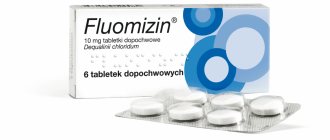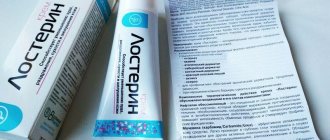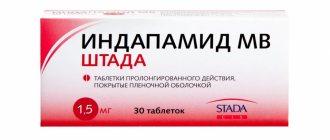Diuretics are one of the groups of drugs used in the treatment of hypertension. Indapamide is often prescribed in the complex treatment of arterial hypertension and some cardiovascular diseases; it allows achieving stable and long-term results, including in the elderly.
Composition and release form
Indapamide is produced by different pharmaceutical companies under several names (for example, Indapamide Stada or Teva) in the form:
- long-acting tablets (their name contains the word retard or the letters MB);
- tablets with a special film coating;
- capsules
In all dosage forms, the active ingredient is the same - indapamide. In long-acting tablets, its dosage can be 1.5 mg, and in regular tablets and capsules - only 2.5 mg. Sold in cardboard boxes of 30 or 60 pieces, complete with instructions.
Auxiliary components are represented by colloidal silicon dioxide, magnesium stearate, lactose, microcrystalline cellulose. But each manufacturer has the right to produce medicine using its own technology, so the composition must be specified in the instructions for the product being purchased.
Effect of the drug
Indapamide has a triple effect:
- has a diuretic effect;
- reduces blood pressure;
- dilates blood vessels.
When taking 1.5-2.5 mg of the drug, a hypotensive effect appears, but without a noticeable diuretic effect. This feature allows the drug to be used to lower blood pressure for a long time.
When the dosage is increased, the hypotensive effect does not increase, but the diuretic effect appears.
A noticeable decrease in blood pressure occurs only after 7 days of taking the medicine; a lasting effect can be expected no earlier than after 3 months.
Thanks to the drug, vascular resistance is reduced by reducing the force of contraction of the smooth muscles of the arteries, and the size of the left ventricle of the heart returns to normal.
Indications for use
The instructions for use contain information about what Indapamide helps with. It is prescribed for arterial hypertension, as well as for chronic heart failure caused by sodium and water retention in the body.
The drug does not affect the metabolism of carbohydrates and fats, therefore it is indicated:
- people diagnosed with diabetes;
- patients with high cholesterol;
- people with one kidney or on hemodialysis.
Indap capsules 2.5 mg No. 10x3
Name
Indap.
Description
Main active ingredient
Indapamide.
Release form
Capsules.
Dosage
2.5 mg.
Preclinical data regarding the safety of the drug
The results of experimental toxicological studies of indapamide are very favorable. Signs of acute toxicity are caused only by megadoses, the lethal dose is 300 - 1000 mg/kg body weight, subacute toxicity when administered orally for three months was observed in laboratory rats at a dose of 1000 mg, chronic toxicity at a dose of 30 mg occurs due to hypokalemia. Testing for mutagenicity, carcinogenicity, and reproductive toxicity gave negative results.
Pharmacological group
Diuretics. Sulfonamides. ATS code: C03BA11.
Pharmacodynamics
Indapamide is a non-thiazide sulfonamide derivative with an indole ring, pharmacologically similar to thiazide diuretics, which act by inhibiting sodium reabsorption in the cortical segment of the distal tubule of the nephron. Indapamide increases the excretion of sodium and chlorides in the urine, and to a lesser extent the excretion of potassium and magnesium, thereby increasing the volume of urine formation; the drug has an antihypertensive effect. The antihypertensive effect is also maintained in anephric hypertensive patients. Like other diuretics, the vascular mechanism of action of indapamide includes: A decrease in the tone of the smooth muscles of the vascular walls associated with the transmembrane exchange of ions (primarily calcium). Stimulation of the synthesis of prostaglandin PGE2 and prostacyclin PGI2 (vasodilator and platelet aggregation inhibitor). Indapamide reduces left ventricular hypertrophy of the heart. With thiazide and similar diuretics, the therapeutic effect no longer increases after a certain dose, and side effects increase. Therefore, if treatment is ineffective, it is not recommended to increase the dose. Indapamide does not affect the levels of LDL and HDL cholesterol and blood glucose.
Pharmacokinetics
Absorption The bioavailability of indapamide is very high (93%). The time required to achieve maximum serum concentration (Tmax) ranges from 1-2 hours after taking a dose of 2.5 mg. Distribution More than 75% of indapamide is bound to proteins in plasma. The half-life is 14-24 hours (average 18 hours). Repeated administration of indapamide increases the steady state plasma concentration compared with a single dose. The steady state remains stable and no cumulative effect is observed. Metabolism: 60-80% of the dose taken is excreted by the kidneys. Indapamide is mainly excreted in the form of metabolites, 5% is excreted in unchanged form. In renal failure, pharmacokinetic parameters do not change.
Indications for use
Arterial hypertension.
Directions for use and doses
Prescribe 2.5 mg (1 capsule) per day, in the morning, regardless of meals. The capsules are swallowed without biting and washed down with water. The drug can be used in combination with other antihypertensive drugs, with the exception of diuretics. If treatment is insufficiently effective, the dose of Indap should not be increased; it is better to start taking an additional antihypertensive drug. When higher doses of indipamide are used, the antihypertensive effect does not increase, only its saluretic effect increases.
Use during pregnancy and lactation
During pregnancy, diuretics are usually not prescribed to women. Under no circumstances should the drug be used to treat physiological edema during pregnancy. Diuretics can cause fetoplacental ischemia, which poses a threat to fetal growth. Indapamide passes into breast milk, so breastfeeding should be stopped while taking the drug.
Impact on the ability to drive vehicles and other mechanisms
Typically, INDAP® does not affect the level of attention. However, in some cases, especially at the beginning of treatment or when combined with other antihypertensive drugs, due to a decrease in blood pressure, the level of attention may decrease, which will negatively affect the ability to drive vehicles and operate machinery.
Precautionary measures
If liver function is impaired, thiazide diuretics can cause hepatic encephalopathy. In this case, the use of diuretics must be stopped immediately. Plasma sodium levels: Plasma sodium concentrations should be determined before starting treatment and changes monitored at regular intervals thereafter. Treatment with diuretics may be accompanied by hyponatremia, sometimes with very serious consequences, while in the initial stage the decrease in sodium concentration in the blood may be asymptomatic. Therefore, it is recommended to regularly monitor plasma sodium levels, especially in elderly patients and those suffering from liver cirrhosis. Plasma potassium levels: Long-term use of thiazide and similar diuretics is associated with a risk of decreased plasma potassium concentrations and the development of hypokalemia. The occurrence of hypokalemia in patients must be prevented. This is especially true for elderly people, patients suffering from exhaustion, as well as patients taking other medications simultaneously with a diuretic drug, patients suffering from cirrhotic ascites with edema, as well as patients with coronary vascular diseases and cardiac dysfunction who are predisposed to arrhythmia ( hypokalemia increases the toxic effects of digitalis preparations on the heart). An increased risk of hypokalemia is also typical for patients with an increased QT interval, regardless of the genesis of this phenomenon, which can be congenital or iatrogenic. Hypokalemia, as well as bradycardia, in this case predisposes to the occurrence of severe arrhythmias, including fatal ventricular tachycardia (torsades de pointes). In all of these cases, it is necessary to monitor plasma potassium concentrations more frequently. An examination to detect possible hypokalemia should be carried out in the first week of treatment. If signs of hypokalemia are detected, appropriate measures should be taken to prevent it. Plasma calcium levels: Thiazide and similar diuretics may decrease urinary calcium excretion, which may result in a small and temporary increase in plasma calcium concentrations. Hypercalcemia may result from previously undetected hyperparathyroidism. In this case, treatment should be stopped and the function of the parathyroid glands should be examined. Blood glucose levels: In patients with diabetes, especially in the presence of hypokalemia, it is necessary to regularly monitor blood glucose levels. Uric acid level: In patients with elevated uric acid concentrations, attacks of gout are possible, so the dose of the drug must be adjusted depending on the current levels of its level in plasma. Thiazide and thiazide-like diuretics are most effective only with normal or minimally reduced renal function (plasma creatinine level less than 25 mg/l, i.e. 220 micromol/l in adults). Hypovolemia caused by loss of water and sodium, when treated with diuretics, reduces glomerular filtration, which is sometimes accompanied by an increase in plasma urea and creatinine levels. In patients with normal renal function, such temporary functional renal failure usually does not lead to serious consequences, however, its occurrence can significantly aggravate existing renal failure. Indapamide may cause a positive reaction in doping tests. The drug contains lactose. Patients with a rare hereditary disease of galactose intolerance, Lapp lactase deficiency or impaired absorption of glucose and galactose are not recommended to use this drug.
Interaction with other drugs
Undesirable combinations: Concomitant use of indapamide with lithium may lead to an increase in the level of lithium in the blood plasma with signs of overdose, for example, with a salt-free diet (reduced urinary excretion of lithium). If the use of diuretics is necessary, plasma lithium levels should be systematically monitored and the dose adjusted accordingly. Certain drugs (astemizole, bepridil, erythromycin, halofantrine, sultopride, terfenadine, vincamine) taken together with indapamide may cause torsades de pointes in patients suffering from hypokalemia, bradycardia or a prolonged QT interval. Combinations requiring increased caution: Systemically administered nonsteroidal antirheumatic drugs and high doses of salicylates may reduce the antihypertensive effect of indapamide. Dehydrated patients are at risk of acute renal failure (decreased glomerular filtration). Therefore, at the beginning of treatment, the patient should drink large amounts of water while systematically monitoring kidney function. Amphotericin B
Amfotericin B
(iv), glucocorticoids and mineralocorticoids used systemically, tetracosactide, contact laxatives can cause hypokalemia (the effect is cumulative). Plasma potassium levels should be monitored and adjusted if necessary, especially during concomitant treatment with digoxin. Baclofen increases the antihypertensive effect. At the beginning of treatment, the patient should drink large amounts of water while systematically monitoring kidney function. In patients using digoxin, existing hypokalemia may increase the risk of digoxin toxicity. In these cases, plasma potassium levels should be systematically monitored, an ECG should be recorded, and treatment should be changed if necessary. Angiotensin-converting enzyme (ACE) inhibitors at the beginning of treatment and with simultaneous sodium deficiency (especially in people with renal artery stenosis) increase the risk of sudden hypotension or acute renal failure. In case of essential hypertension, when previous therapy with diuretics could cause sodium deficiency, it is recommended to stop taking diuretics three days before starting treatment with an ACE inhibitor. In chronic heart failure, when indapamide is combined with an ACE inhibitor, it is necessary to begin treatment with a very low dose of ACE inhibitor and a low dose of diuretic. In this case, during the first weeks of treatment with an ACE inhibitor, it is necessary to systematically monitor renal function (plasma creatinine level). When taking class Ia (quinidine, disopyramide) and class III antiarrhythmic drugs (amiodarone, bretylium, sotalol) simultaneously, it is necessary to take into account the risk of ventricular tachycardia (a predisposing factor is hypokalemia, bradycardia and an already existing increased QT interval). When taking metformin, there is a risk of lactic acidosis associated with possible renal failure due to the use of diuretics (most often loop diuretics). It is recommended not to prescribe metformin if plasma creatinine levels exceed 15 mg/L (135 micromol/L) in men and 12 mg/L (110 micromol/L) in women. High doses of iodinated contrast agents in combination with indapamide and with simultaneous dehydration increase the risk of acute kidney failure. Imipramine (tricyclic) antidepressants and antipsychotics increase the antihypertensive effect and increase the risk of orthostatic hypotension (the effect is cumulative). When taking calcium salts, there is a risk of hypercalcemia as a result of a decrease in calcium excretion in the urine. Cyclosporine carries a risk of increasing plasma creatinine levels without changing circulating levels of cyclosporine (even without decreasing the water/sodium ratio). Corticosteroids, due to sodium and water retention, may reduce the antihypertensive effect. Prescription with potassium-sparing diuretics (amiloride, spironolactone, triamterene) is a rational combination, very useful for some patients, does not exclude the possibility of hypokalemia, and in patients with renal dysfunction or diabetes, hyperkalemia. In these cases, the level of potassium in the plasma should be monitored, an ECG if necessary, and if necessary, change the treatment.
Contraindications
severe forms of renal failure severe forms of liver failure (including hepatic encephalopathy) hypokalemia increased sensitivity to sulfonamide derivatives or excipients of the drug children under 18 years of age pregnancy and lactation.
Compound
1 capsule contains 2.50 mg of indapamide (indapamidum) Excipients: granulated microcrystalline cellulose, lactose monohydrate, corn starch, magnesium stearate, colloidal silicon dioxide; gelatin capsule composition: gelatin, indigo carmine, titanium dioxide.
Overdose
Indapamide was found to have no toxic effect up to a dose of 40 mg, i.e. 16 times the therapeutic dose. Signs of acute poisoning are symptoms of hypovelaemia (hyponatremia, hypokalemia). The following may be observed: nausea, vomiting, hypotension, convulsions, dizziness, drowsiness, states of confusion and confusion, polyuria or oliguria and even anuria (as a result of hypovolemia). Treatment: gastric lavage, correction of water and electrolyte balance, symptomatic therapy. There is no specific antidote.
Side effect
Most side effects affecting clinical and laboratory parameters are dose dependent. In some cases, nausea, constipation, dry mouth, dizziness, fatigue, paresthesia, and headaches may occur. As a rule, adverse reactions decrease as the dose is reduced. Very rarely, pancreatitis may occur. Persons predisposed to allergic and asthmatic reactions may experience hypersensitivity reactions, especially dermatological ones. In the case of existing acute disseminated lupus erythematosus, there is a danger of worsening the condition, the appearance of a maculopapular rash on the skin, purpura. In case of liver failure, encephalopathy may occur (see Contraindications, Special warnings and precautions for use). Along with this, taking indapamide can cause changes in laboratory parameters in the form of potassium deficiency leading to hypokalemia, especially in risk groups (see section Special warnings and precautions for use), and can also cause hyponatremia with hypovolemia leading to dehydration and orthostatic hypotension. In clinical studies, when taking a therapeutic dose after treatment lasting 4-6 weeks, cases of hypokalemia were observed (plasma potassium levels did not exceed 3.4 mmol/L in 25% of patients and less than 3.2% mmol/L in 10% of patients) . After treatment for 12 weeks, the mean decrease in plasma potassium levels reached 0.41 mmol/l. The simultaneous loss of chloride ions can cause secondary metabolic alkalosis. The likelihood and intensity of this effect is low. It is necessary to carefully weigh the indications when prescribing this diuretic drug to patients with gout or diabetes if they experience an increase in uric acid and blood sugar levels during treatment. In some cases, hematological diseases (thrombocytopenia, leukopenia, aplastic anemia, hemolytic anemia) may occur. In exceptional cases, hypercalcemia may develop.
Storage conditions
Store in a dry place, protected from light, at a temperature not exceeding 25 °C. Keep away from children.
Buy Indap capsules 2.5 mg No. 10x3 in the pharmacy
Price for Indap capsules 2.5 mg No. 10x3
Instructions for use for Indap capsules 2.5 mg No. 10x3
Indapamide: how and in what doses to take
The method and regimen of use depend on the prescribed dosage of the drug.
- A 2.5 mg tablet is taken once a day in the morning. If the hypotensive effect does not appear within 14 days, then the dose is increased to 2-3 tablets per day. The maximum daily dose is 10 mg, which should be divided into two doses;
- a long-acting tablet of 1.5 mg is taken once a day in the morning, but if the effectiveness is weak, after 1.5-2 months the treatment should be supplemented with a drug that is not a diuretic. With long-term therapy, increasing the dose is not advisable due to the increased risk of side effects without normalizing blood pressure.
To eliminate edema in chronic heart failure, Indapamide is prescribed at a dose of 5-7.5 mg per day for 7-14 days.
Indap®
Undesirable combinations
Lithium preparations
An increase in the concentration of lithium in the blood plasma, accompanied by the manifestation of overdose symptoms as with a salt-free diet (reduced excretion of lithium in the urine).
If necessary, diuretic drugs can be used in combination with lithium preparations; in this case, the lithium content in the blood plasma should be systematically monitored and the dose of the drug should be adjusted accordingly.
Combinations requiring increased caution
Medicines that can cause aritis
- class 1a antiarrhythmic drugs (quinidine, hydroquinidine, disopyramide);
- class III antiarrhythmic drugs (amiodarone, sotalol, dofetilide, ibutilide);
- some antipsychotic drugs (neuroleptics): phenothiazines (chlorpromazine, cyamemazine, levomepromazine, thioridazine, trifluoroperazine), benzamides (amisulpride, sulpiride, sultopride, tiapride), butyrophenones (droperidol, haloperidol);
- others: bepridil, cisapride, difemanil, erythromycin IV, halofantrine, mizolastine, pentamidine, sparfloxacin, moxifloxacin, astemizole, vincamine IV.
Increased risk of ventricular arrhythmias, especially polymorphic ventricular tachycardia of the “pirouette” type (hypokalemia is a risk factor).
Before using the above combinations of drugs, it is necessary to determine the concentration of potassium in the blood plasma and, accordingly, take the necessary measures to correct the condition before starting combination therapy with indapamide. It is necessary to monitor the patient’s clinical condition, the concentration of plasma electrolytes and ECG parameters.
In patients with identified hypokalemia, drugs that do not cause polymorphic ventricular tachycardia of the “pirouette” type should be used.
Nonsteroidal anti-inflammatory drugs (systemic), including selective cyclooxygenase-2 (COX-2) inhibitors and acetylsalicylic acid in high doses (≥ 3 g/day)
The antihypertensive effect of indapamide may be reduced.
There is a risk of developing acute renal failure in patients with dehydration due to decreased glomerular filtration.
Fluid loss should be compensated and renal function monitored at the beginning of treatment.
Angiotensin-converting enzyme (ACE) inhibitors
There is a risk of developing sudden arterial hypotension and/or acute renal failure in combination with ACE inhibitors against the background of an already existing reduced concentration of sodium ions in the blood plasma (especially in patients with renal artery stenosis).
In case of arterial hypertension, when previous treatment with diuretics could lead to sodium deficiency, it is necessary:
- stop taking the diuretic 3 days before starting treatment with an ACE inhibitor and then resume, if necessary, taking a non-potassium-sparing diuretic;
- or start taking an ACE inhibitor with a low dose and gradually increase its dose, if necessary.
In chronic heart failure, treatment with ACE inhibitors should begin with the lowest dose, with a possible preliminary reduction in the dose of the concomitant non-potassium-sparing diuretic.
In all cases, during the first weeks of taking ACE inhibitors, it is necessary to monitor renal function (plasma creatinine levels).
Other drugs that cause hypokalemia: amphotericin B (iv), glucocorticoids and mineralocorticoids (systemic use), tetracosactide, stimulant (irritant) laxatives
Increased risk of hypokalemia (additive effect).
It is necessary to monitor the concentration of potassium ions in the blood plasma and adjust if necessary, especially when taking cardiac glycosides simultaneously. It is recommended to use non-stimulant laxatives.
Baclofen
Strengthening the antihypertensive effect. The patient's fluid balance should be restored and renal function monitored at the beginning of treatment.
Cardiac glycosides
Hypokalemia can enhance the toxic effect of cardiac glycosides. In such cases, the concentration of potassium ions in the blood plasma, ECG indicators should be monitored, and, if necessary, therapy should be adjusted.
Combinations that require attention
Potassium-sparing diuretics (amiloride, spironolactone, triamterene)
Although the combination is appropriate in some patients, hypokalemia or hyperkalemia may occur (especially in patients with renal failure or diabetes mellitus). The content of potassium ions in the blood plasma, ECG indicators should be monitored and, if necessary, therapy should be adjusted.
Metformin
Increased risk of lactic acidosis caused by metformin and associated with possible impairment of renal function during the use of diuretics and especially loop diuretics. Metformin should not be used if the plasma creatinine level exceeds 15 mg/l (135 µmol/l) in men and 12 mg/l (110 µmol/l) in women.
Iodine-containing radiocontrast agents
Dehydration while taking diuretics increases the risk of developing acute renal failure, especially when using iodine-containing radiocontrast agents in high doses.
It is necessary to compensate for fluid loss before administering an iodine-containing radiocontrast agent.
Imipramine-like antidepressants, antipsychotics
Increased antihypertensive effect and increased risk of orthostatic hypotension (additive effect).
Calcium salts
Risk of hypercalcemia due to decreased urinary calcium excretion.
Cyclosporine, tacrolimus
Risk of an increase in plasma creatinine without any change in circulating cyclosporine levels, even in the absence of a decrease in fluid/sodium ions.
Corticosteroid drugs, tetracosactide (if administered systemically)
Reduced antihypertensive effect (corticosteroids cause fluid and sodium ion retention).
Is Indapamide safe for pregnant women?
Due to the fact that no serious studies have been conducted on the effect of the drug on pregnant women, tablets and capsules are prohibited during pregnancy. There is a risk of fetoplacental insufficiency, leading to slower fetal development.
The substance can pass into breast milk, therefore, when treating with the drug during lactation, breastfeeding should be stopped.
Indapamide is not suitable for the treatment of physiological edema in pregnancy.
Contraindications and side effects
According to the instructions for use of Indapamide, the drug is contraindicated in:
- hypersensitivity to the main substance;
- acute cerebrovascular accident;
- severe diabetes mellitus;
- advanced form of gout;
- serious renal dysfunction;
- severe liver diseases.
Since the substance removes fluid from the body, it can cause dehydration and a decrease in the concentration of potassium and sodium in the body. In rare cases, arrhythmia and hemolytic anemia may occur.
Main side effects:
- allergies (in the form of skin itching, rash, photosensitivity);
- arrhythmia or tachycardia;
- dry mouth and nausea;
- headache and sleep disturbances;
- epigastric pain;
- constipation or diarrhea.
Taking the drug may provoke changes in well-being due to a decrease in blood pressure, so it is better to avoid activities that require special care.
Indap®
Undesirable combinations
Lithium preparations
An increase in the concentration of lithium in the blood plasma, accompanied by symptoms of overdose, as with a salt-free diet (reduced excretion of lithium in the urine). If necessary, diuretic drugs can be used in combination with lithium preparations; in this case, the lithium content in the blood plasma should be systematically monitored and the dose of the drug should be adjusted accordingly.
Combinations requiring increased caution
Medicines that can cause aritis
- class Ia antiarrhythmic drugs (quinidine, hydroquinidine, disopyramide);
- class III antiarrhythmic drugs (amiodarone, sogalol, bretylium, dofetilide, ibutilide);
- some antipsychotic drugs (neuroleptics): phenothiazines (chlorpromazine, cyamemazine, levomepromazine, thioridazine, trifluoroperazine), benzamides (amisulpride, sulpiride, sultopride, tiapride), butyrophenones (droperidol, haloperidol);
- others: bepridil, cisapride, difemanil, erythromycin IV. halofantrine. mizolastine, pentamidine, sparfloxacin, moxifloxacin, astemizole, vincamine IV, terfenadine.
Increased risk of ventricular arrhythmias, especially polymorphic ventricular tachycardia of the “pirouette” type (hypokalemia, bradycardia and prolonged QT interval are risk factors).
Before using the above combinations of drugs, it is necessary to determine the concentration of potassium in the blood plasma and, accordingly, take the necessary measures to correct the condition before starting combination therapy with indapamide. It is necessary to monitor the patient’s clinical condition, the concentration of plasma electrolytes and ECG parameters.
In patients with identified hypokalemia, drugs that do not cause polymorphic ventricular tachycardia of the “pirouette” type should be used.
Nonsteroidal anti-inflammatory drugs (systemic), including selective cyclooxygenase-2 (COX-2) inhibitors and acetylsalicylic acid in high doses (≥ 3 g/day)
The antihypertensive effect of indapamide may be reduced.
There is a risk of developing acute renal failure in patients with dehydration due to decreased glomerular filtration.
Fluid loss should be compensated and renal function monitored at the beginning of treatment.
Angiotensin-converting enzyme (ACE) inhibitors
There is a risk of developing sudden arterial hypotension and/or acute renal failure when indapamide is combined with ACE inhibitors in patients with reduced concentrations of sodium ions in the blood plasma (especially in patients with renal artery stenosis).
For arterial hypertension,
when previous treatment with diuretics could lead to sodium deficiency, it is necessary to stop taking the diuretic 3 days before starting treatment with an ACE inhibitor and then resume, if necessary, taking a non-potassium-sparing diuretic.
For chronic heart failure
When indapamide is combined with an ACE inhibitor, treatment with ACE inhibitors should begin with the lowest dose, with a possible preliminary reduction in the dose of the concomitant potassium-sparing diuretic.
In all the above special cases
When indapamide is combined with ACE inhibitors, during the first weeks of taking ACE inhibitors, it is necessary to monitor renal function (plasma creatinine levels).
Other drugs that cause hypokalemia: amphotericin B (iv), glucocorticoids and mineralocorticoids (systemic use), tetracosactide, stimulant (irritant) laxatives.
Increased risk of hypokalemia (additive effect).
It is necessary to monitor the concentration of potassium ions in the blood plasma and adjust if necessary, especially when taking cardiac glycosides (digoxin) simultaneously. It is recommended to use non-stimulant laxatives.
Baclofen
Strengthening the antihypertensive effect. The patient's fluid balance should be restored and renal function monitored at the beginning of treatment.
Cardiac glycosides
Hypokalemia can enhance the toxic effect of cardiac glycosides (digoxin). In such cases, the concentration of potassium ions in the blood plasma, ECG indicators should be monitored, and, if necessary, therapy should be adjusted.
Combinations that require attention
Potassium-sparing diuretics (amiloride, spironolactone, triamterene)
Although the combination is appropriate in some patients, hypokalemia or hyperkalemia may occur (especially in patients with renal failure or diabetes mellitus). The content of potassium ions in the blood plasma, ECG indicators, etc. should be monitored. if necessary, adjust therapy.
Metformin
Increased risk of lactic acidosis caused by metformin and associated with possible impairment of renal function during the use of diuretics and especially loop diuretics. Metformin should not be used if the plasma creatinine level exceeds 15 mg/l (135 µmol/l) in men and 12 mg/l (110 µmol/l) in women.
Iodine-containing radiocontrast agents
Dehydration while taking diuretics increases the risk of developing acute renal failure, especially when using iodine-containing radiocontrast agents in high doses.
It is necessary to compensate for fluid loss before administering an iodine-containing radiocontrast agent.
Imipramine-like (tricyclic) antidepressants, antipsychotics
Increased antihypertensive effect and increased risk of orthostatic hypotension (additive effect).
Calcium salts
Risk of hypercalcemia due to decreased urinary calcium excretion.
Cyclosporine, tacrolimus
Risk of an increase in plasma creatinine without any change in circulating cyclosporine levels, even in the absence of a decrease in fluid/sodium ions.
Corticosteroid drugs, tetracosactide (if administered systemically)
Reduced antihypertensive effect (corticosteroids cause fluid and sodium ion retention).






